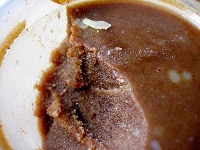Concentrate
 Leftovers are the very fabric of happiness. Half the fun of Thanksgiving dinner is making cold turkey and stuffing sandwiches the next day.
Leftovers are the very fabric of happiness. Half the fun of Thanksgiving dinner is making cold turkey and stuffing sandwiches the next day.
I’m grooving on the leftovers of Saturday’s dinner: braised beef short ribs that Anita bought from Bristol Farms last week on spec, knowing that I’d make good use of them. I used a really simple treatment and they rewarded me by tasting absolutely wonderful. We ate them Saturday night with polenta and roasted brussel sprouts.
The real party started Sunday, though, when we made sandwiches from the leftovers. Pulling apart the meat was just the start. I had about a quarter-cup of the sauce left over that, refrigerated, set up like meat-wine jelly. Demi-glace, more or less, only without the tomato. Perfect for spreading on bread with a little mayo.
The First Braised Short Ribs of Fall
- 2.5# beef short ribs
- 2 medium onions cut into half-inch slices
- 1 medium carrot roughly cut (3/4-inch chunks)
- 1.5 c full-bodied red wine (e.g. syrah, zinfandel)
- 2 c chicken stock or broth
- 4-5 sprigs fresh thyme
- Olive oil
- Salt & pepper
- 2-4 T butter
Preheat oven to 225 degrees. Liberally salt and judiciously pepper the short ribs. Haul out your dutch oven or other large, deep, heavy, ovenproof pot. Heat the pan over a medium-high flame until it’s way too hot to touch. A droplet of water should bounce off the bottom of the pan. Really hot. Pour in 2-3 tablespoons of olive oil. Maybe even four. Enough to coat the bottom of the pan with style and grace. Let the oil heat up.
Turn on your hood. Open the windows. Close the door to the living room. Genuflect. Crank the flame up to afterburner and USING TONGS, gently lower the ribs into the pan and sear all sides until a good brown crust appears. Do not crowd the pan. Sear the ribs in batches if you have to, but keep that pan Top-Gun hot. Don’t burn the meat, but don’t wimp out on the sear: if it just looks gray, you’re not done yet. Keep your kitchen clean (ish) by covering your pan with a spatter guard. As you finish the ribs, remove them to a plate. Nice and brown all over, right? This whole affair will probably take 10-15 minutes.
After the meat is done, dump in the onions and carrot with a half-teaspoon of salt. Sweat the vegetables until the onions are translucent. If you want a sweeter sauce, you could go until they’re golden. Pour in half the stock and half the wine. Use a wooden spoon to loosen any browned bits sticking to the pan. Put the ribs back in the pot along with any juice that’s pooled on the plate. Add the rest of both stock and wine slowly, stopping if the liquid level threatens to submerge the meat. At least 1/4 of the typical meat-and-bone mass should be poking out above the liquid. Add the thyme. Bring to a low boil, cover, and put in the oven and cook for three hours or until you can have your way with the meat. It should be soft and falling off the bone, easy to pull apart (see bonus note below).
Put the meat on a plate and tent it with aluminum foil. Pour whatever is left in the pan through a strainer, and then get the resulting delicious liquid back on the stove in a skillet or saucier. If you didn’t go the way of the extra bonus note, you’ll want to skim as much fat off the top as you can.
Reduce the defatted liquid over medium-high heat until it’s thick enough to coat the back of a spoon. Kill the flame and stir in a couple of tablespoons of butter. Taste while holding onto the counter top so that when your eyes roll back into your head you won’t fall over. Adjust the seasonings. Add more butter if you think it needs it. Plate the meat and drizzle some sauce over it. Don’t blow all the sauce on your guests. Save some that you can put in the refrigerator and spread on sandwiches after it gelatinizes.
Bonus note: You can make this recipe both more tasty and easier to handle by executing it over the course of a couple of days. After the meat has cooked, cool the pot and then refrigerate. It will be fine for a few days. When you’re ready to serve, skim the congealed fat, reheat gently until all is liquid again, and then continue as above.



